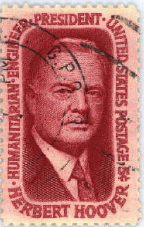Conservative Policies Prevail
In keeping with the prevailing prosperity, at least in the urban areas of the country, American governmental policy during the 1920s was eminently conservative. It was based upon the belief that if government did what it could to foster private business, prosperity would trickle down to all ranks of the population.
Accordingly, Republican policies were intended to create the
most favorable conditions for American industry. The tariff acts
of 1922 and 1930 brought tariff barriers to new heights,
guaranteeing to American manufacturers in one field after another a
monopoly of the domestic market. The second of these tariffs,
the Smoot-Hawley Act of 1930, embodied rates so
high
that over a thousand American economists petitioned
 President Hoover to veto it, and subsequent events
bore out their predictions of costly retaliation by other nations. At the same
time, the federal government started a program of tax reduction, reflecting
Secretary of the Treasury Andrew Mellon's belief
that high income taxes would prevent the rich from investing in new industrial
enterprises. Congress, in a series of laws passed between 1921 and
1929, responded favorably to his proposals that wartime taxes on
income, excess profit taxes, and corporation taxes be repealed
outright or drastically reduced.
President Hoover to veto it, and subsequent events
bore out their predictions of costly retaliation by other nations. At the same
time, the federal government started a program of tax reduction, reflecting
Secretary of the Treasury Andrew Mellon's belief
that high income taxes would prevent the rich from investing in new industrial
enterprises. Congress, in a series of laws passed between 1921 and
1929, responded favorably to his proposals that wartime taxes on
income, excess profit taxes, and corporation taxes be repealed
outright or drastically reduced.
Throughout the 1920s, private business received substantial encouragement, including construction loans, profitable mailcarrying contracts, and other indfrect subsidies. The Transportation Acts of 1920 had already restored to private management the nation's railroad system, which had been under strict governmental control during the war. The Merchant Marine, which had been owned and largely operated by the government from 1917 to 1920, was sold to private operators.
But the executive and legislative branches of government found themselves at odds in the field of electric power. Two great nitrate plants had been built by the government during the war at the foot of Muscle Shoal, a 59-kilometer stretch of rapids in the Tennessee River, and a series of dams had also been erected along the river to generate power. A measure providing for public generation and sale of power had passed both houses of Congress in 1928, but President Hoover returned it with a stinging veto. Later, during Franklin D. Roosevelt's Presidency, the model TVA (Tennessee Valley Authority), experiment was built out of the Muscle Shoals project.
Meanwhile, Republican policies in agriculture were meeting mounting criticism, for farmers shared least in the well-being of the 1920s. The period from 1900 to 1920 had been one of general farm prosperity and rising farm prices, with the unprecedented wartime demand for American farm products providing strong stimulus to production. Farmers had opened up poor lands long allowed to remain idle or never before cultivated. As the money value of American farms doubled and in some areas tripled, farmers began to buy goods and machinery they had never been able to afford before. But by the end of 1920, with the abrupt cessation of wartime demand, the commercial agriculture of staple crops fell into a sharp decline. When the general depression came in the 1930s, it merely aggravated a condition already serious.
